Abstract
1 PD 117302, a new nonpeptide opioid compound shown in in vitro studies to be a selective kappa-opioid agonist, has been evaluated in vivo for antinociceptive activity and other effects characteristic of kappa-receptor activation. 2 Dose-related long lasting antinociception was produced by PD 117302 against a mechanical noxious stimulus in rats following intravenous, subcutaneous or oral administration. 3 PD 117302 was effective in raising the nociceptive threshold to mechanical and chemical but not to thermal noxious stimuli in the mouse. This effect was attenuated in animals pretreated with the opioid antagonist naloxone. 4 In addition to producing antinociception, PD 117302 also caused naloxone-reversible locomotor impairment and diuresis, effects that are typical of kappa-agonists. 5 PD 117302 did not cause respiratory depression, inhibition of gastrointestinal motility or naloxone-precipatated withdrawal jumping in mice, effects that are associated with actions at the mu-opioid receptor. 6 The pharmacological profile of PD 117302 in vivo is consistent with in vitro data suggesting that PD 117302 is a selective agonist at the kappa-opioid receptor.
Full text
PDF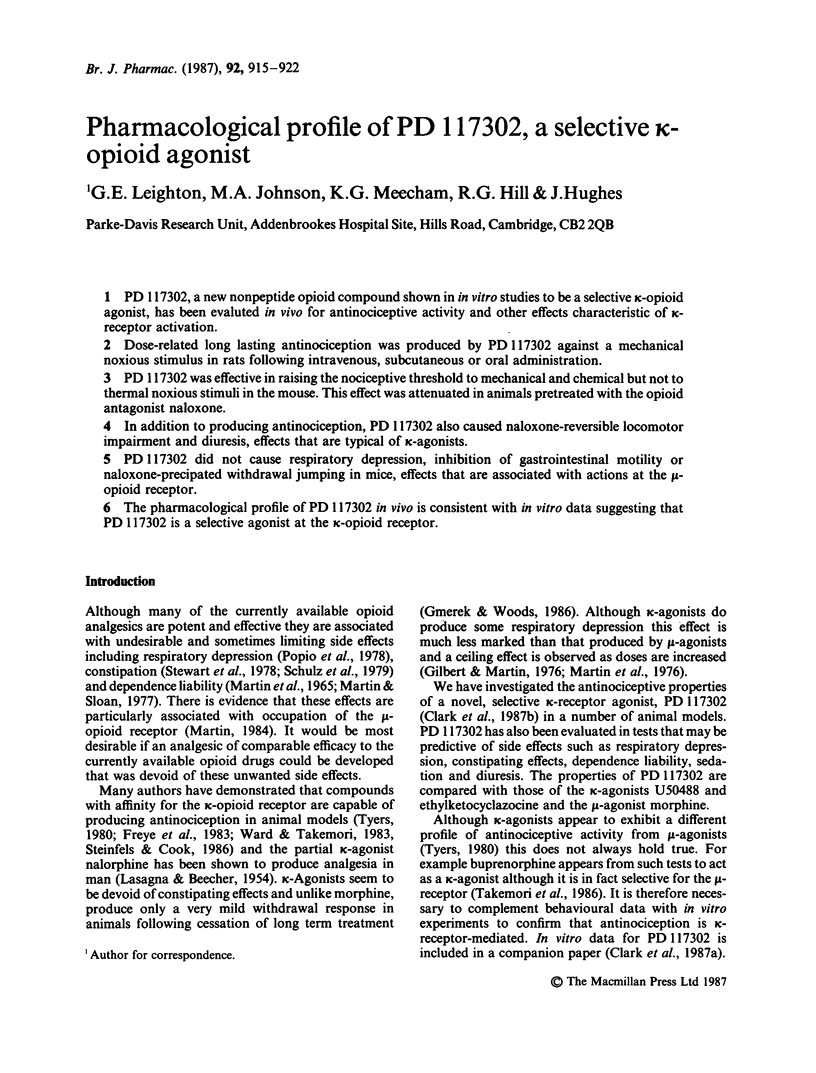
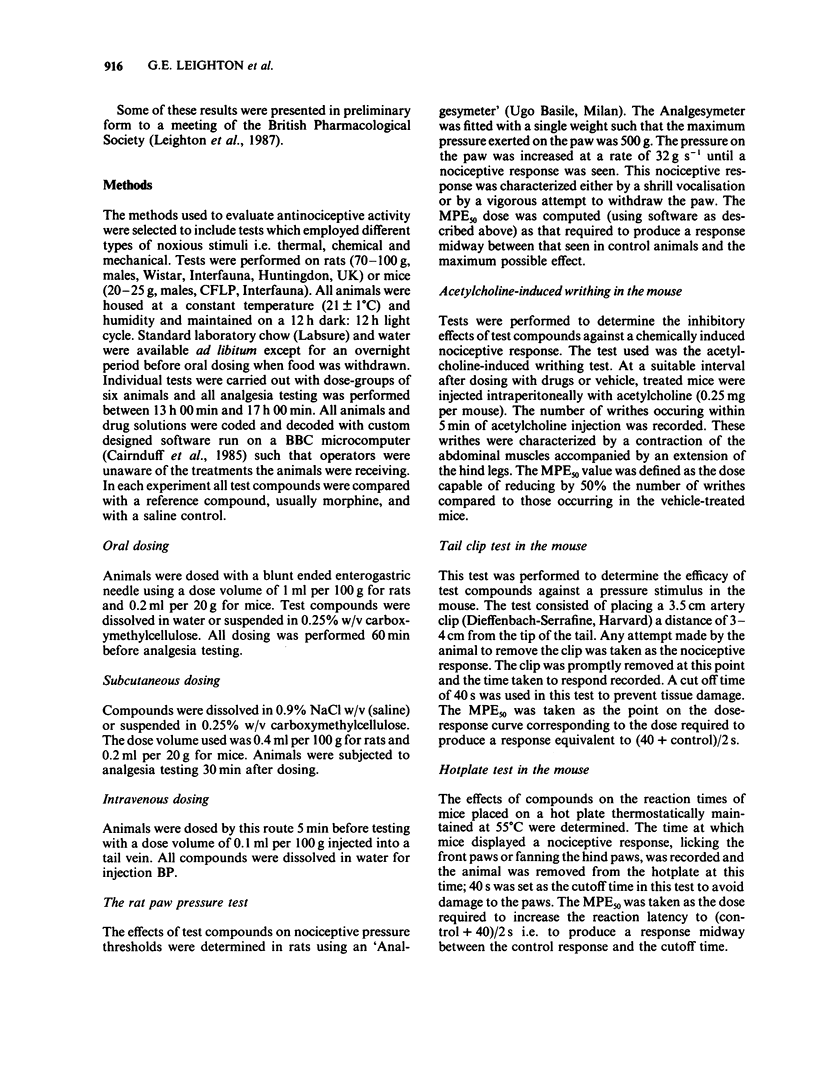
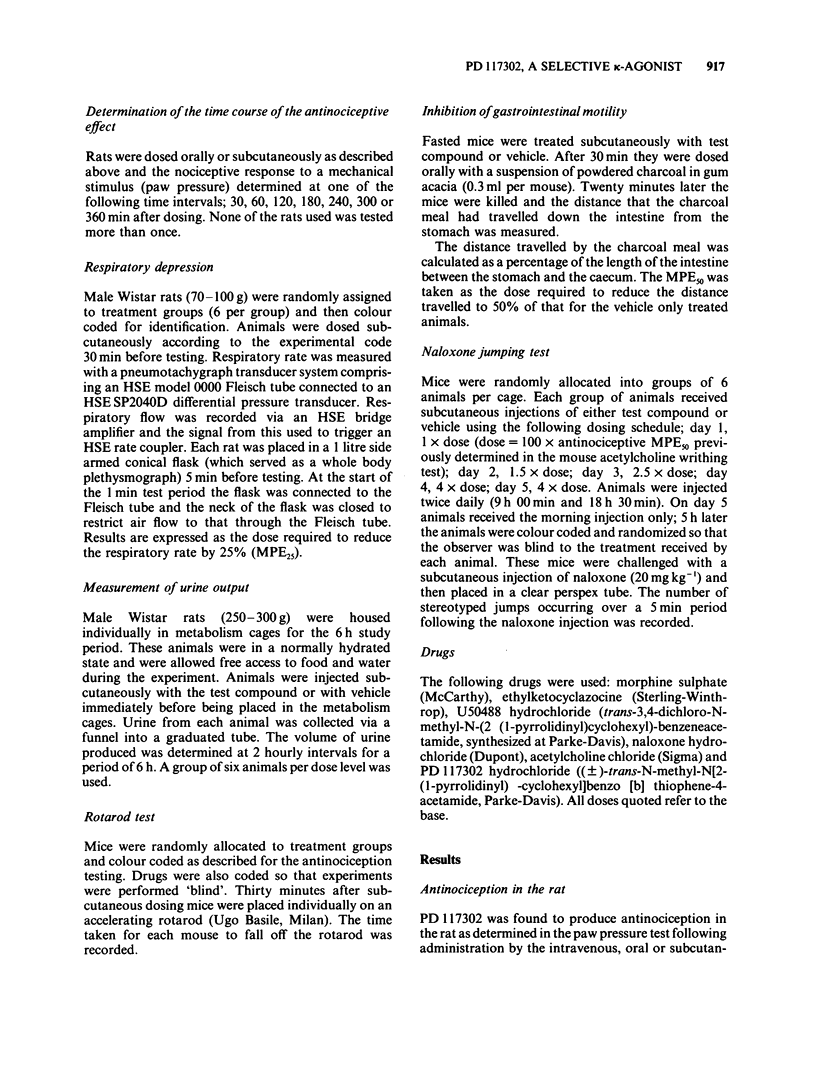
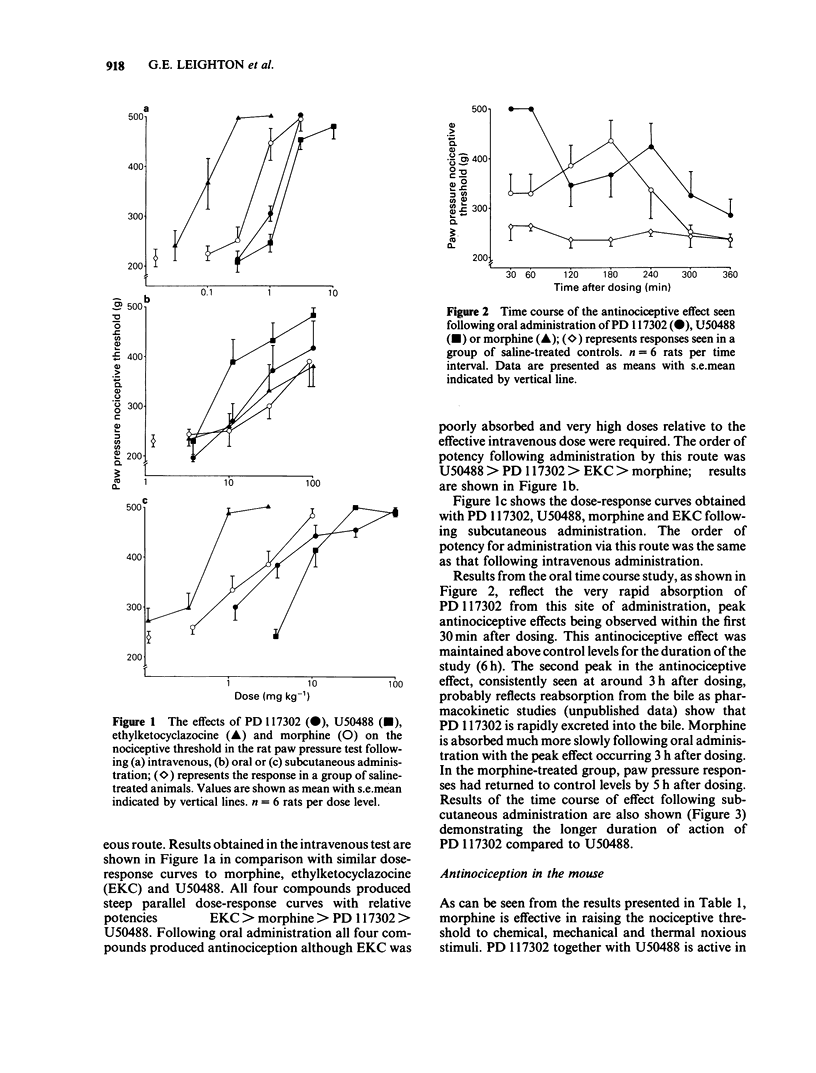
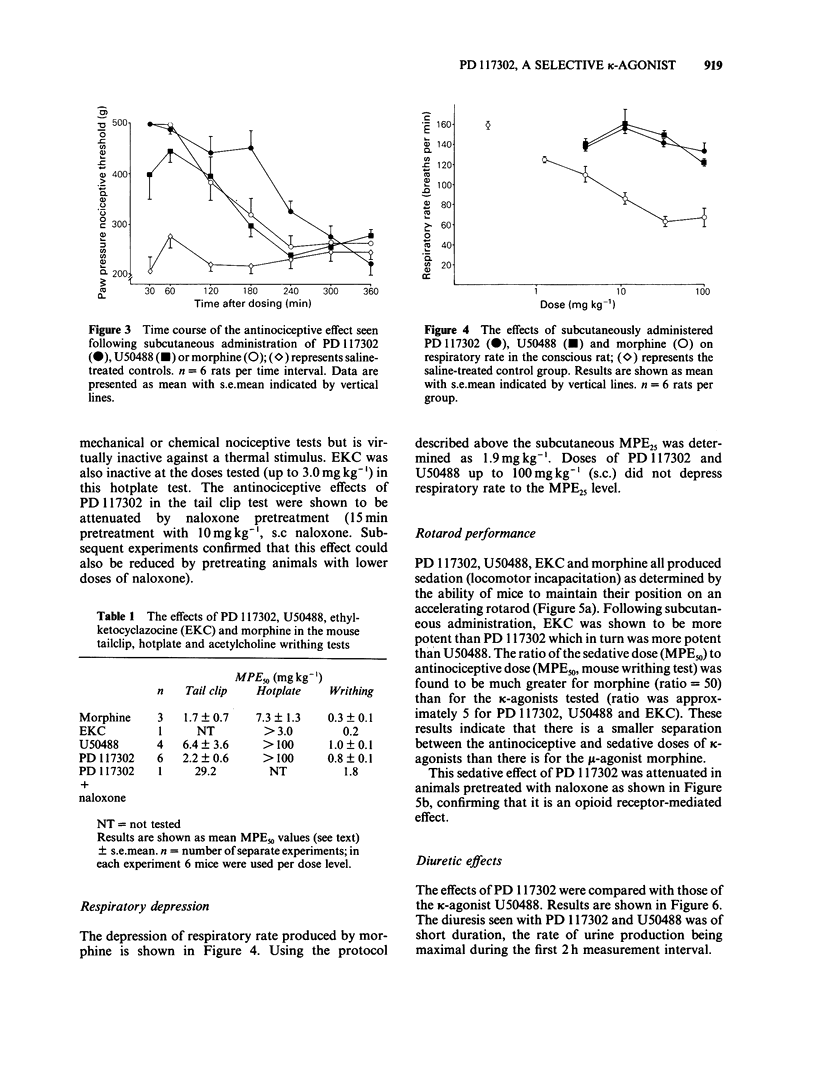
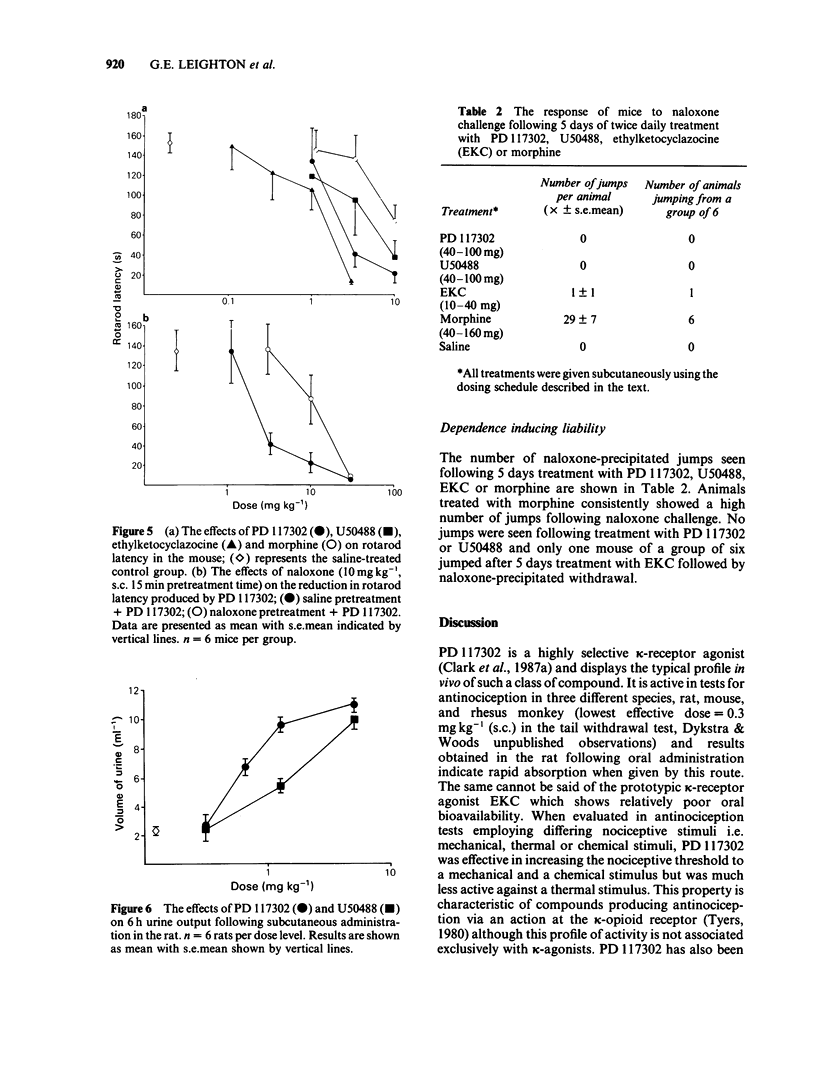
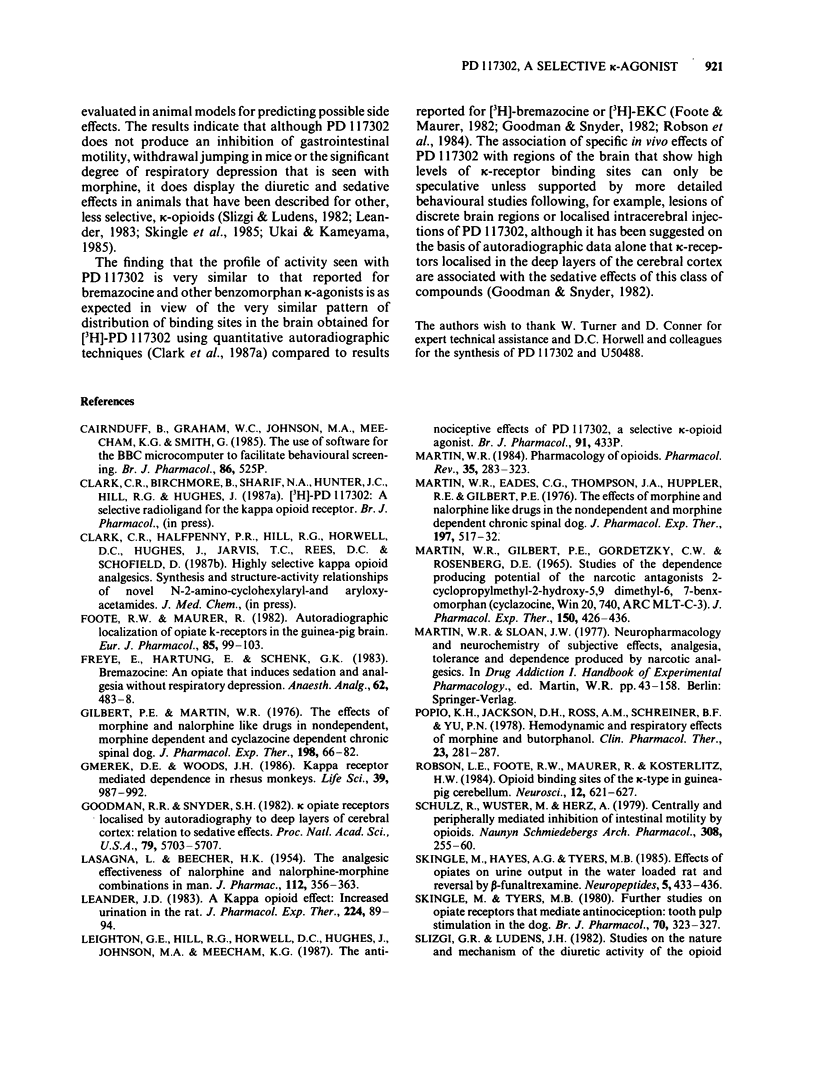
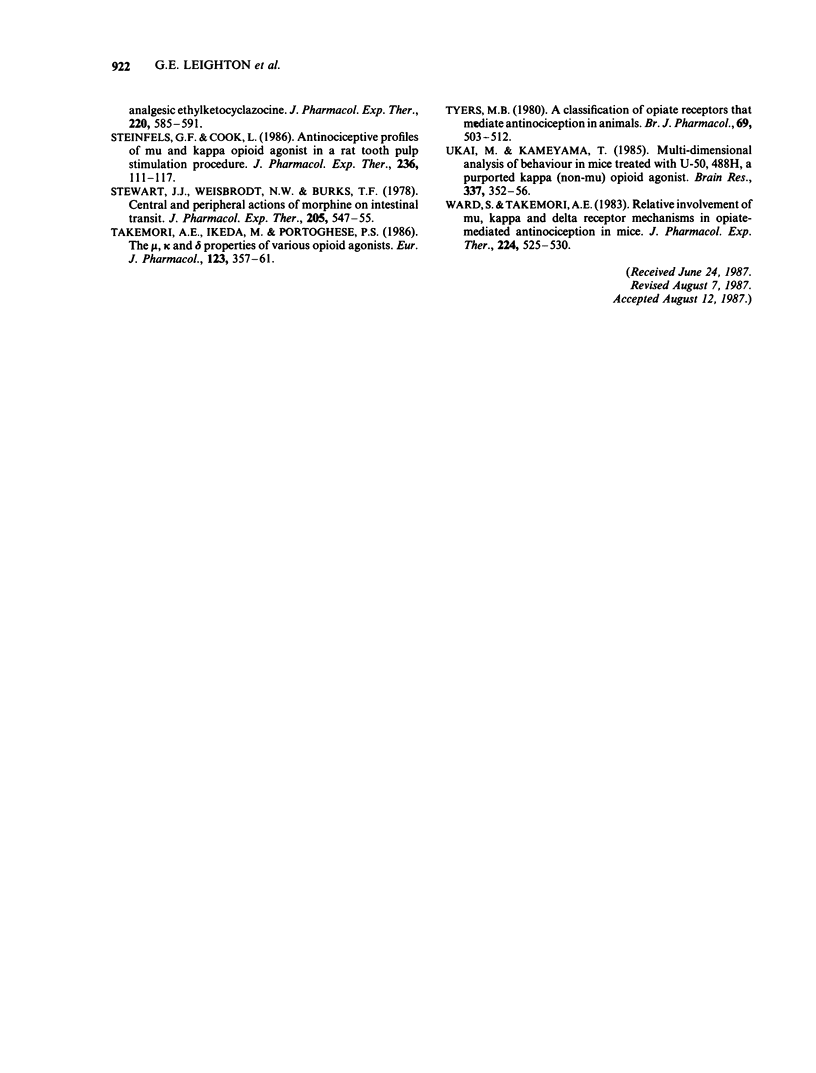
Selected References
These references are in PubMed. This may not be the complete list of references from this article.
- Foote R. W., Maurer R. Autoradiographic localization of opiate kappa-receptors in the guinea-pig brain. Eur J Pharmacol. 1982 Nov 5;85(1):99–103. doi: 10.1016/0014-2999(82)90429-0. [DOI] [PubMed] [Google Scholar]
- Freye E., Hartung E., Schenk G. K. Bremazocine: an opiate that induces sedation and analgesia without respiratory depression. Anesth Analg. 1983 May;62(5):483–488. [PubMed] [Google Scholar]
- Gilbert P. E., Martin W. R. The effects of morphine and nalorphine-like drugs in the nondependent, morphine-dependent and cyclazocine-dependent chronic spinal dog. J Pharmacol Exp Ther. 1976 Jul;198(1):66–82. [PubMed] [Google Scholar]
- Gmerek D. E., Woods J. H. Kappa receptor mediated opioid dependence in rhesus monkeys. Life Sci. 1986 Sep 15;39(11):987–992. doi: 10.1016/0024-3205(86)90287-0. [DOI] [PubMed] [Google Scholar]
- Goodman R. R., Snyder S. H. Kappa opiate receptors localized by autoradiography to deep layers of cerebral cortex: relation to sedative effects. Proc Natl Acad Sci U S A. 1982 Sep;79(18):5703–5707. doi: 10.1073/pnas.79.18.5703. [DOI] [PMC free article] [PubMed] [Google Scholar]
- LASAGNA L., BEECHER H. K. The analgesic effectiveness of nalorphine and nalorphine-morphine combinations in man. J Pharmacol Exp Ther. 1954 Nov;112(3):356–363. [PubMed] [Google Scholar]
- Leander J. D. A kappa opioid effect: increased urination in the rat. J Pharmacol Exp Ther. 1983 Jan;224(1):89–94. [PubMed] [Google Scholar]
- Martin W. R., Eades C. G., Thompson J. A., Huppler R. E., Gilbert P. E. The effects of morphine- and nalorphine- like drugs in the nondependent and morphine-dependent chronic spinal dog. J Pharmacol Exp Ther. 1976 Jun;197(3):517–532. [PubMed] [Google Scholar]
- Martin W. R., Fraser H. F., Gorodetzky C. W., Rosenberg D. E. Studies of the dependence-producing potential of the narcotic antagonist 2-cyclopropylmethyl-2'-hydroxy-5,9-dimethyl-6,7-benzomorphan (cyclazocine, WIN-20,740, ARC II-c-3). J Pharmacol Exp Ther. 1965 Dec;150(3):426–436. [PubMed] [Google Scholar]
- Martin W. R. Pharmacology of opioids. Pharmacol Rev. 1983 Dec;35(4):283–323. [PubMed] [Google Scholar]
- Popio K. A., Jackson D. H., Ross A. M., Schreiner B. F., Yu P. N. Hemodynamic and respiratory effects of morphine and butorphanol. Clin Pharmacol Ther. 1978 Mar;23(3):281–287. doi: 10.1002/cpt1978233281. [DOI] [PubMed] [Google Scholar]
- Robson L. E., Foote R. W., Maurer R., Kosterlitz H. W. Opioid binding sites of the kappa-type in guinea-pig cerebellum. Neuroscience. 1984 Jun;12(2):621–627. doi: 10.1016/0306-4522(84)90077-0. [DOI] [PubMed] [Google Scholar]
- Schulz R., Wüster M., Herz A. Centrally and peripherally mediated inhibition of intestinal motility by opioids. Naunyn Schmiedebergs Arch Pharmacol. 1979 Sep;308(3):255–260. doi: 10.1007/BF00501390. [DOI] [PubMed] [Google Scholar]
- Skingle M., Hayes A. G., Tyers M. B. Effects of opiates on urine output in the water-loaded rat and reversal by beta-funaltrexamine. Neuropeptides. 1985 Feb;5(4-6):433–436. doi: 10.1016/0143-4179(85)90047-2. [DOI] [PubMed] [Google Scholar]
- Skingle M., Tyers M. B. Further studies on opiate receptors that mediate antinoception: tooth pulp stimulation in the dog. Br J Pharmacol. 1980 Oct;70(2):323–327. doi: 10.1111/j.1476-5381.1980.tb07939.x. [DOI] [PMC free article] [PubMed] [Google Scholar]
- Slizgi G. R., Ludens J. H. Studies on the nature and mechanism of the diuretic activity of the opioid analgesic ethylketocyclazocine. J Pharmacol Exp Ther. 1982 Mar;220(3):585–591. [PubMed] [Google Scholar]
- Steinfels G. F., Cook L. Antinociceptive profiles of mu and kappa opioid agonists in a rat tooth pulp stimulation procedure. J Pharmacol Exp Ther. 1986 Jan;236(1):111–117. [PubMed] [Google Scholar]
- Stewart J. J., Weisbrodt N. W., Burks T. F. Central and peripheral actions of morphine on intestinal transit. J Pharmacol Exp Ther. 1978 Jun;205(3):547–555. [PubMed] [Google Scholar]
- Takemori A. E., Ikeda M., Portoghese P. S. The mu, kappa and delta properties of various opioid agonists. Eur J Pharmacol. 1986 Apr 29;123(3):357–361. doi: 10.1016/0014-2999(86)90709-0. [DOI] [PubMed] [Google Scholar]
- Tyers M. B. A classification of opiate receptors that mediate antinociception in animals. Br J Pharmacol. 1980 Jul;69(3):503–512. doi: 10.1111/j.1476-5381.1980.tb07041.x. [DOI] [PMC free article] [PubMed] [Google Scholar]
- Ukai M., Kameyama T. Multi-dimensional analyses of behavior in mice treated with U-50,488H, a purported kappa (non-mu) opioid agonist. Brain Res. 1985 Jul 1;337(2):352–356. doi: 10.1016/0006-8993(85)90074-5. [DOI] [PubMed] [Google Scholar]
- Ward S. J., Takemori A. E. Relative involvement of mu, kappa and delta receptor mechanisms in opiate-mediated antinociception in mice. J Pharmacol Exp Ther. 1983 Mar;224(3):525–530. [PubMed] [Google Scholar]


